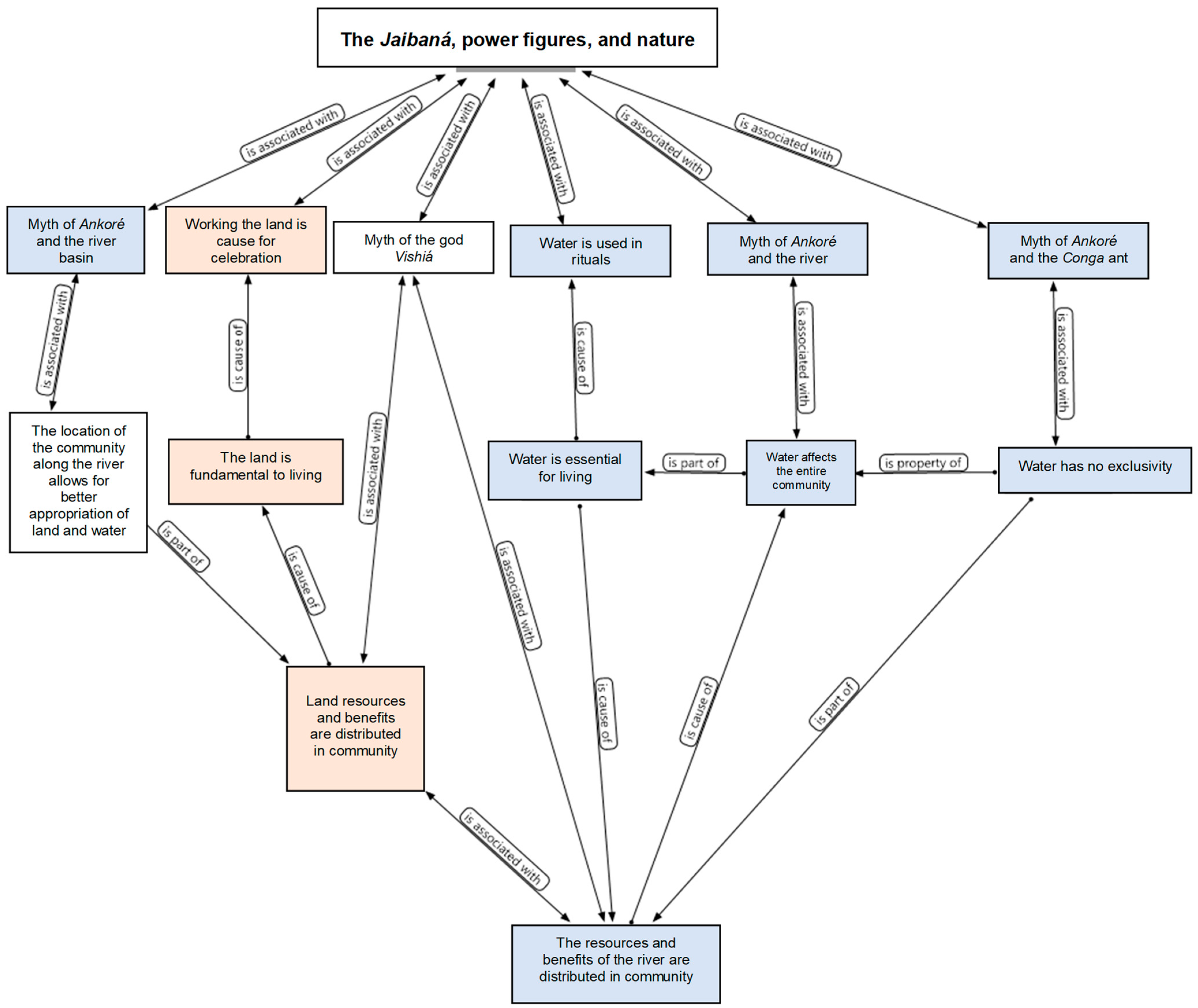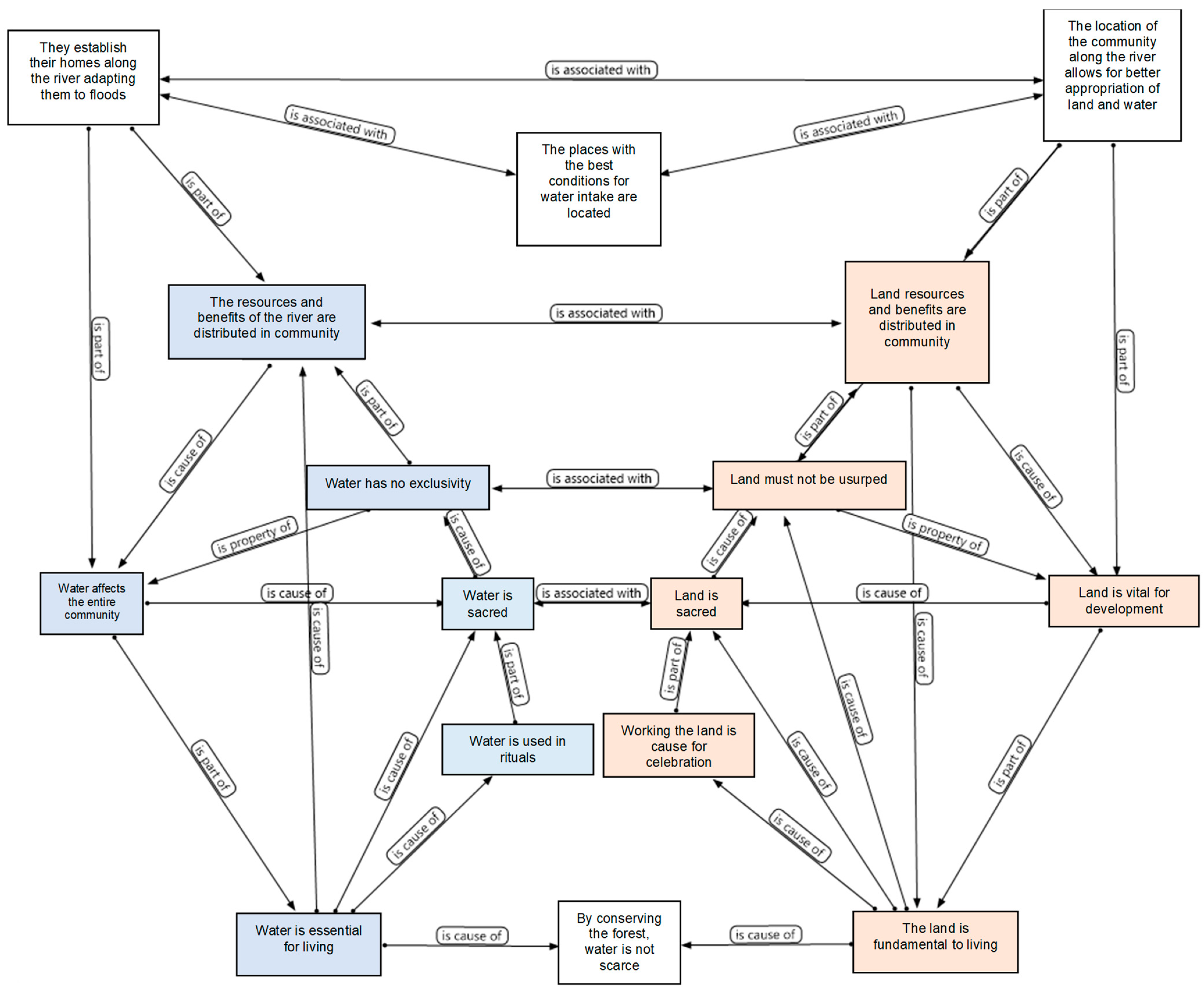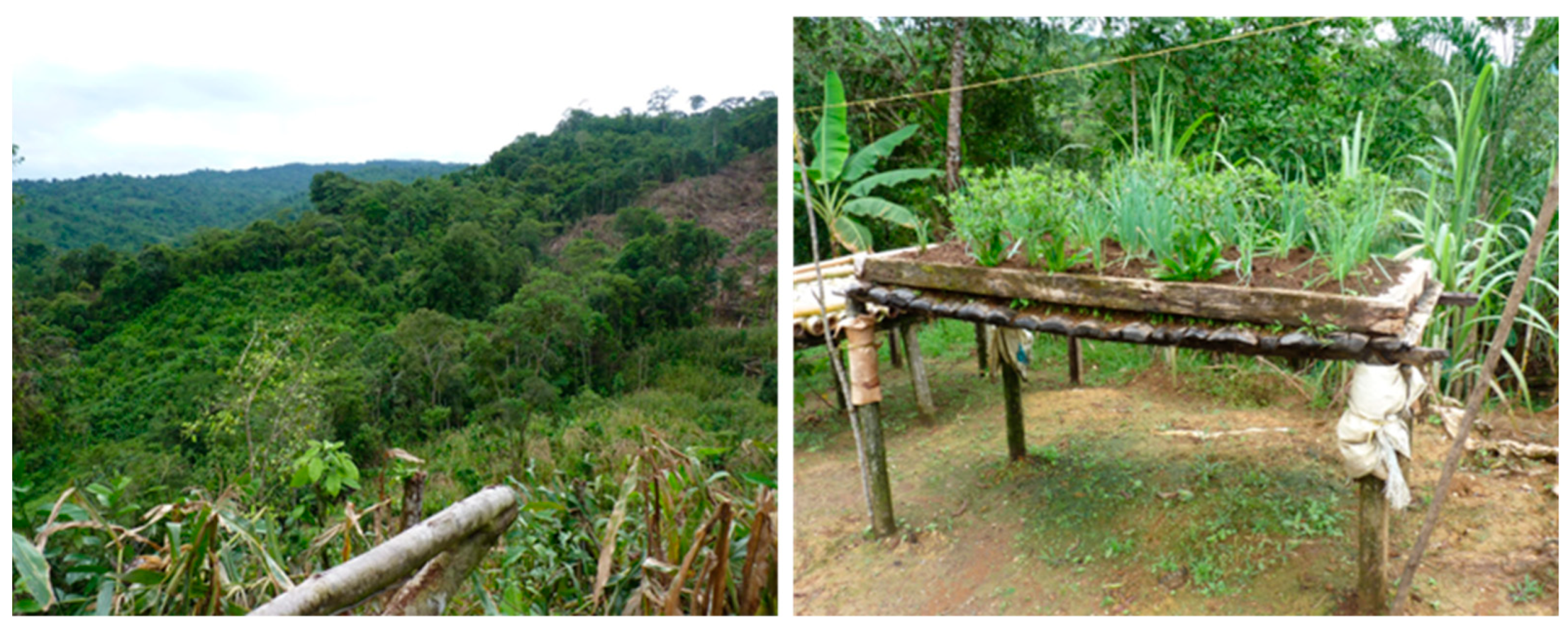Ancestral Practices for Water and Land Management: Experiences in a Latin American Indigenous Reserve
Abstract
1. Introduction
2. Development of the Emberá Community: Change and Resilience Processes
3. Social Resilience under Change Scenarios
4. Methodology
4.1. Study Population
4.2. Information Collection
4.3. Information Analysis
5. Results and Discussion
5.1. Preserving the Basin with Rites and Myths
5.2. Water and Land Governance
5.3. Resistance to Change and Environmental Impacts
6. Conclusions
Author Contributions
Funding
Informed Consent Statement
Acknowledgments
Conflicts of Interest
References
- Ledezma-Rentería, E.D.; Galeano, G. Usos de las palmas en las tierras bajas del pacífico colombiano. Caldasia 2014, 36, 71–84. [Google Scholar] [CrossRef]
- Rojas-Morales, J.A.; Escobar-Lasso, S.; Osorio-Ortíz, A.; Lozano-Ríos, L.A. Third Observation of the Chocoan Blunt-Headed Vine Snake, Imantodes Chocoensis for Colombia. Biota Colomb. 2013, 14, 340–343. [Google Scholar]
- Iiap. Investigación/Contribución al Conocimientocientífico de la Realidad Biológica, Económica, Y Sociocultural del Chocó Biogeográfico; Minambiente: Bogotá, Columbia, 2019. [Google Scholar]
- Lam, D.P.M.; Hinz, E.; Lang, D.; Tengö, M.; Wehrden, H.; Martín-López, B. Indigenous and Local Knowledge in Sustainability Transformations Research: A Literature Review. Ecol. Soc. 2020, 25, 1–25. [Google Scholar] [CrossRef]
- Luna-Bravo, J.L. El Simbolismo de los Contrastes en el Mito Indígena Emberá; Universidad de Santo Tomás, Facultad de Filosofía: Bogotá, Colombia, 2009; ISBN 978-958-631-585-2. [Google Scholar]
- Hernández, C.A.; del Pilar Valencia, M. Emberás: Territorio y Biodiversidad: Estrategias de Control en Escenarios de Conflicto; Programa Semillas: Bogotá, Colombia, 2001; ISBN 978-958-96612-7-7. [Google Scholar]
- Rosique-Gracia, J.; Gálvez-Abadía, A.; Turbay, S.; Domicó, N.; Domicó, A.; Chavarí, P.; Domicó, J.; Alzate, F.A.; Navarro, J.F.; Rojas-Mora, S. «Todos en el mismo pensamiento»: Las relaciones del pueblo embera con los sitios sagrados de los resguardos de Polines y Yaberaradó en Chigorodó (Antioquia). Tabula Rasa 2020, 36, 201–222. [Google Scholar]
- Dumaza-Chajito, I. Identidad Cultural de los Pueblos Embera-Dóbida: Estrategias para el Reconocimiento y el Respeto de los Valores Culturales Autóctonos en el Aula; Universidad Nacional Abierta y a Distancia: Bogotá, Colombia, 2019; Available online: https://repository.unad.edu.co/handle/10596/28183 (accessed on 1 April 2023).
- Cannon, T.; Müller-Mahn, D. Vulnerability, Resilience and Development Discourses in Context of Climate Change. Nat. Hazards 2010, 55, 621–635. [Google Scholar] [CrossRef]
- Blasch, J.; van der Grijp, N.M.; Petrovics, D.; Palm, J.; Bocken, N.; Darby, S.J.; Barnes, J.; Hansen, P.; Kamin, T.; Golob, U.; et al. New Clean Energy Communities in Polycentric Settings: Four Avenues for Future Research. Energy Res. Soc. Sci. 2021, 82, 102276. [Google Scholar] [CrossRef]
- Thomalla, F.; Downing, T.; Spanger-Siegfried, E.; Han, G.; Rockström, J. Reducing Hazard Vulnerability: Towards a Common Approach between Disaster Risk Reduction and Climate Adaptation. Disasters 2006, 30, 39–48. [Google Scholar] [CrossRef]
- Bifani, P. La globalización: ¿otra caja de Pandora? Universidad de Granada: Granada, Spain, 2002; ISBN 978-84-338-2870-5. [Google Scholar]
- Max-Neef, M.A.; Hopenhayn, M. Desarrollo a Escala Humana: Conceptos, Aplicaciones y Algunas Reflexiones; Icaria Editorial: Montevideo, Uruguay, 1994; ISBN 978-84-7426-217-9. [Google Scholar]
- Eschenhagen, M.L. Argumentos para repensar el “desarrollo”. Innovar 2001, 17, 109–122. [Google Scholar]
- DANE Cuentas Nacionales Departamentales: PIB Por Departamento. Available online: https://www.dane.gov.co/index.php/estadisticas-por-tema/cuentas-nacionales/cuentas-nacionales-departamentales (accessed on 31 March 2023).
- Rubio, J.A.P. Sociología y Desarrollo: El Reto del Desarrollo Sostenible; Ministerio de Agricultura, Pesca y Alimentación: Madrid, Spain, 2007; ISBN 978-84-491-0779-5.
- Douglas, M. Natural Symbols: Explorations in Cosmology; Routledge: London, UK, 2004; ISBN 978-1-134-37951-4. [Google Scholar]
- Escobar, A. El lugar de la naturaleza y la naturaleza del lugar: ¿globalización o postdesarrollo? In Proceedings of the La Colonialidad Del Saber: Eurocentrismo y Ciencias Sociales; Perspectivas latinoamericanas; Consejo Latinoamericano de Ciencias Sociales (CLACSO): Buenos Aires, Argentina, 1993; pp. 108–138. ISBN 950-9231-51-7. [Google Scholar]
- Martínez-Alier, J. El Ecologismo de Los Pobres: Conflictos Ambientales y Lenguajes de Valoración, 5th ed.; Icaria antrazyt; Icaria: Barcelona, Spain, 2011; ISBN 978-84-9888-393-0. [Google Scholar]
- Támara, F.C. Antropología y Ambiente: Enfoques Para una Comprensión de la Relación Ecosistema-Cultura; Pontificia Universidad Javeriana: Bogotá, Colombia, 2002; ISBN 978-958-683-511-4. [Google Scholar]
- Leff-Zimmerman, E. Los Problemas del Conocimiento y la Perspectiva Ambiental del Desarrollo; Universidad Autónoma de México: Mexico City, Mexico, 2016; ISBN 978-968-23-2277-8. [Google Scholar]
- Glewwe, P.; Kremer, M. Chapter 16 Schools, Teachers, and Education Outcomes in Developing Countries. In Handbook of the Economics of Education; Hanushek, E., Welch, F., Eds.; Elsevier: Amsterdam, The Netherlands, 2006; Volume 2, pp. 945–1017. [Google Scholar]
- Karlsson, S.; Srebotnjak, T.; Gonzales, P. Understanding the North–South Knowledge Divide and Its Implications for Policy: A Quantitative Analysis of the Generation of Scientific Knowledge in the Environmental Sciences. Environ. Sci. Policy 2007, 10, 668–684. [Google Scholar] [CrossRef]
- Adger, W.N. Social and Ecological Resilience: Are They Related? Prog. Hum. Geogr. 2000, 24, 347–364. [Google Scholar] [CrossRef]
- Hervani, A.A.; Nandi, S.; Helms, M.M.; Sarkis, J. A Performance Measurement Framework for Socially Sustainable and Resilient Supply Chains Using Environmental Goods Valuation Methods. Sustain. Prod. Consum. 2022, 30, 31–52. [Google Scholar] [CrossRef]
- Leff-Zimmerman, E. Sobre la Articulación de Las Ciencias en La Relación Naturaleza Sociedad; Opiniones Sectores específicos; Centro Internacional de Formación de Ciencias Ambientales: Bogotá, Columbia, 1982. [Google Scholar]
- UNESCO. UNESCO and the Struggle against Ethnocide: Declaration of San José, December 1981—UNESCO Biblioteca Digital. Available online: https://unesdoc.unesco.org/ark:/48223/pf0000049951 (accessed on 31 March 2023).
- Batalla, G.B.; Aravena, F.R. América Latina, Etnodesarrollo y Etnocidio; Ediciones FLACSO: Ciudad de Guatemala, Gautemala, 1982; ISBN 978-84-89401-02-0. [Google Scholar]
- Kadykalo, A.N.; López-Rodriguez, M.D.; Ainscough, J.; Droste, N.; Ryu, H.; Ávila-Flores, G.; Le Clec’h, S.; Muñoz, M.C.; Nilsson, L.; Rana, S.; et al. Disentangling ‘Ecosystem Services’ and ‘Nature’s Contributions to People’. Ecosyst. People 2019, 15, 269–287. [Google Scholar] [CrossRef]
- Costanza, R. Valuing Natural Capital and Ecosystem Services toward the Goals of Efficiency, Fairness, and Sustainability. Ecosyst. Serv. 2020, 43, 101096. [Google Scholar] [CrossRef]
- Holdridge, L.; Jiménez Saa, H. Ecología Basada en Zonas de Vida; Instituto Interamericano de Ciencias Agrícolas: San José, Costa Rica, 1978; ISBN 978-92-9039-131-9. [Google Scholar]
- IDEAM Estudio Nacional del Agua 2010 Observatorio Ambiental de Bogotá. Available online: https://oab.ambientebogota.gov.co/?post_type=dlm_download&p=3696 (accessed on 31 March 2023).
- Hammersley, M.; Atkinson, P. Etnografía: Métodos de Investigación; Paidós Ibérica: Madrid, Spain, 1994; ISBN 978-84-493-0012-7. [Google Scholar]
- Rodríguez-Garavito, C. Ethnicity.Gov: Global Governance, Indigenous Peoples, and the Right to Prior Consultation in Social Minefields. Indiana J. Glob. Leg. Stud. 2011, 18, 263–305. [Google Scholar] [CrossRef]
- Padawangi, R.; Douglass, M. Water, Water Everywhere: Toward Participatory Solutions to Chronic Urban Flooding in Jakarta. Pac. Aff. 2015, 88, 517–550. [Google Scholar] [CrossRef]
- Cresswell, J. Including Social Discourses and Experience in Research on Refugees, Race, and Ethnicity. Discourse Soc. 2012, 23, 553–575. [Google Scholar] [CrossRef]
- Curtis, E.; Paine, S.-J.; Jiang, Y.; Jones, P.; Tomash, I.; Healey, O.; Reid, P. Examining Emergency Department Inequities in Aotearoa New Zealand: Findings from a National Retrospective Observational Study Examining Indigenous Emergency Care Outcomes. Emerg. Med. Australas. 2022, 34, 16–23. [Google Scholar] [CrossRef]
- Pecore, J.L.; Nagle, C.; Welty, T.; Kim, M.; Demetrikopoulos, M. Science Teacher Candidates’ Questioning and Discussion Skill Performance in a Virtual Simulation Using Experiential Deliberate Practice. J. Sci. Teach. Educ. 2022, 4, 415–435. [Google Scholar] [CrossRef]
- Couch, D.; Nesterova, Y.; Nguyen, H. Examining Non-Indigenous Teacher Perceptions of Indigenous Students in Taiwan through a Strategic Relational Approach. Asia Pac. Educ. Rev. 2023, 1, 1–12. [Google Scholar] [CrossRef]
- Pan, C.-C.; Wang, H.-T.; Pan, Y.-F.; Chao, C.-Y.; Pan, C.-H. “Semaumaq”: The Efficacy and Journey of Facilitating Family Dyadic Interaction in a Paiwan Indigenous Community in Taiwan. Diaspora Indig. Minor. Educ. 2022, 16, 169–184. [Google Scholar] [CrossRef]
- Moser, G. When Photographs Fail, When Monuments Fall: Photography and Reparations in Canada. Photogr. Cult. 2022, 15, 1–17. [Google Scholar] [CrossRef]
- Silva-Caballero, A.; Ball, H.L.; Kramer, K.L.; Bentley, G.R. Sleep Deprivation among Adolescents in Urban and Indigenous-Rural Mexican Communities. Sci. Rep. 2023, 13, 1058. [Google Scholar] [CrossRef] [PubMed]
- Urban, M.; Panchi, E.M.A.; Lee, S.; Brodetsky, E. CINWA (Database of Terminology for Cultivated Plants in Indigenous Languages of Northwestern South America): Introducing a Resource for Research in Ethnobiology, Anthropology, Historical Linguistics, and Interdisciplinary Research on the Neolithic Transition in South America. Lang Resour. Eval. 2022, 1, 1–31. [Google Scholar] [CrossRef]
- Segura Salazar, C.M.; Soto Espinoza, Y.; Castillejos López, W.; Badillo Guzmán, J. Indigenous Women: Experiences and Meanings about the University. Temas Actuales Investig. Educ. 2022, 13, 1–17. [Google Scholar] [CrossRef]
- Varguillas, C. El uso de atlas.Ti y la creatividad del investigador en el análisis cualitativo de contenido upel. Instituto pedagógico rural el mácaro. Laurus 2006, 12, 73–87. [Google Scholar]
- Fortier, C. The Humber Is a Haunting: Settler Deathscapes, Indigenous Spectres, and the Memorialisation of a Canadian Heritage River. Antipode 2022, 54, 259–283. [Google Scholar] [CrossRef]
- Williams, K.; Romero, O.S.G.; Braunstein, M.; Brant, S. Indigenous Philosophies and the “Psychedelic Renaissance”. Anthropol. Conscious. 2022, 33, 506–527. [Google Scholar] [CrossRef]
- Firmo, A.M.S.; Tognella, M.M.P.; Tenório, G.D.; Barboza, R.R.D.; Alves, R.R.N. Habits and Customs of Crab Catchers in Southern Bahia, Brazil. J. Ethnobiol. Ethnomed. 2017, 13, 46. [Google Scholar] [CrossRef]
- Fitzpatrick, K.; Sehgal, A.; Montesanti, S.; Pianarosa, E.; Barnabe, C.; Heyd, A.; Kleissen, T.; Crowshoe, L. Examining the Role of Indigenous Primary Healthcare across the Globe in Supporting Populations during Public Health Crises. Glob. Public Health 2022, 1, 2049845. [Google Scholar] [CrossRef]
- Amaya-Castellanos, C.; Gamboa-Delgado, E.M.; Santacruz-Chasoy, E.; Pelcastre-Villafuerte, B.E. Loss of Ancestral Food Practices and Perception of Its Effect on Children’s Health among Inga Indigenous Grandmothers, Nariño, Colombia. BMC Public Health 2022, 22, 1452. [Google Scholar] [CrossRef]
- Ashencaen Crabtree, S.; Parker, J.; García Segura, A.; Man, Z.; Sylvester, O. Epistemic Hegemonies, Indigenous Methodologies and the Dialectic Turn. Soc. Sci. J. 2022, 1, 2082175. [Google Scholar] [CrossRef]
- Baan, A.; Girik Allo, M.D.; Patak, A.A. The Cultural Attitudes of a Funeral Ritual Discourse in the Indigenous Torajan, Indonesia. Heliyon 2022, 8, e08925. [Google Scholar] [CrossRef] [PubMed]
- McKelvie-Sebileau, P.; Rees, D.; Swinburn, B.; Gerritsen, S.; D’Souza, E.; Tipene-Leach, D. Combining Cognitive Mapping and Indigenous Knowledge to Improve Food Environments in Regional New Zealand. Health Promot. J. Aust. 2022, 33, 631–641. [Google Scholar] [CrossRef] [PubMed]
- Salazar, C.A. La organización social y política de los emberas. Cultura Emberá. In Memorias del Simposio Sobre Cultura Emberá. Quinto Congreso Colombiano de Antropología; Organización Indígena de Antioaquia: Medellín, Colombia, 2022; Available online: https://repositorio.ucaldas.edu.co/handle/ucaldas/17535 (accessed on 31 March 2023).
- Hernández, C.A. Ideas y Prácticas Ambientales Del Pueblo Embera Del Chocó; CEREC: Bogotá, Colombia, 1995; ISBN 978-958-9061-84-8. [Google Scholar]
- Marzo, M.J. Jaibanismo y colonialidad. Los conflictos entre jaibaná en el resguardo Embera-Chamí de Karmata Rua. Antioquia, Colombia. Rev. Kavilando 2019, 11, 148–171. [Google Scholar]
- Barabas, A.M. Cosmovisiones y etnoterritorialidad en las culturas indígenas de oaxaca. Antipoda. Rev. Antropol. Arqueol. 2008, 7, 119–139. [Google Scholar] [CrossRef]
- Pardo, M. Intercambios y resiliencia entre los embera del Chocó, Colombia. Tabula Rasa 2020, 36, 177–200. [Google Scholar] [CrossRef]
- Goharrokhi, M. Sedimentary Processes in Large, Regulated River Systems in the Canadian Subarctic; University of Manitoba: Winnipeg, MB, Canada, 2022; Available online: https://mspace.lib.umanitoba.ca/items/f37d46f2-ff98-4e16-82bb-36f9e0e816bf (accessed on 31 March 2023).
- Cerón, W.L.; Andreoli, R.V.; Kayano, M.T.; Canchala, T.; Ocampo-Marulanda, C.; Avila-Diaz, A.; Antunes, J. Trend Pattern of Heavy and Intense Rainfall Events in Colombia from 1981–2018: A Trend-EOF Approach. Atmosphere 2022, 13, 156. [Google Scholar] [CrossRef]
- Sanchez, V. Emberás Territorio y Biodiversidad Estrategias de Control en Escenarios de Conflicto; SWISSAID: Bogotá, Colombia, 2001; Available online: https://www.swissaid.org.co/emberas-territorio-y-biodiversidad-estrategias-de-control-en-escenarios-de-conflicto/ (accessed on 31 March 2023).
- Morales, D.M. Enfermedad, curación y jaibanismo. Concepciones Emberá sobre las enfermedades más comunes. Bull. L’institut Français D’études Andin. 1994, 23, 317–357. [Google Scholar] [CrossRef]
- Lindón Villoria, A.; Hiernaux Nicolas, D.; Berdoulay, V. Geografías de lo Imaginario, 1st ed.; Obras generales; Anthropos Editorial: Barcelona, Spain, 2012; ISBN 978-84-15260-41-7. [Google Scholar]
- de Sousa Santos, B. A Non-Occidentalist West?: Learned Ignorance and Ecology of Knowledge. Theory Cult. Soc. 2009, 26, 103–125. [Google Scholar] [CrossRef]




| Code | Grounded | Density |
|---|---|---|
| Water affects the whole community | 4 * | 6 * |
| The water in the reserve is clean | 1 | 2 |
| Water is fundamental for life | 8 * | 5 * |
| Water is sacred | 7 * | 5 * |
| Water is a natural resource | 3 * | 1 |
| Water is a satisfier of needs | 8 * | 4 * |
| Water is used in rituals | 5 * | 3 * |
| Water guarantees food security | 5 * | 2 |
| Water is not exclusive | 2 | 5 * |
| Water comes from rain | 2 | 1 |
| Food has become scarce | 3 * | 4 * |
| The Jaibana, power figures, and nature | 3 * | 6 * |
| The Baudó river is a source of food | 1 | 3 * |
| The river is essential for water to flow | 4 * | 3 * |
| They set up their dwellings along the river adapting them to the floods | 3 * | 4 * |
| The rising of the river can cause floods that affect the fish | 3 * | 1 |
| The distribution of the community along the river allows them a better territorial and natural resource appropriation | 1 | 8 * |
| Drought affects the community | 1 | 3 * |
| Land is fundamental for life | 4 * | 7 * |
| Land is sacred | 8 * | 6 * |
| Land is a resource | 1 | 3 * |
| Land is vital for development | 4 * | 7 * |
| Land guarantees food security | 4 * | 6 * |
| Land should not be usurped | 1 | 7 * |
| Resources from the river are shared with the entire community | 3 * | 8 * |
| The resources and benefits provided by the land are distributed among the members of the community | 1 | 10 * |
| Rivers are a means of communication | 1 | 2 |
| The elders and their ancestral knowledge about water and land are respected | 1 | 3 * |
| Myth of Ankoré and the Atrato river basin | 4 * | 2 |
| Myth of Ankoré and the Conga Ant | 2 | 2 |
| Myth of Ankoré and the stream | 1 | 2 |
| Myth of the god Vishiá | 4 * | 3 * |
| Other species also need water | 1 | 3 * |
| The places with the best conditions for water collection have been identified | 1 | 2 |
| If the forest is preserved, the water will not run out | 2 | 2 |
| Working the land is a reason to celebrate | 2 | 3 * |
Disclaimer/Publisher’s Note: The statements, opinions and data contained in all publications are solely those of the individual author(s) and contributor(s) and not of MDPI and/or the editor(s). MDPI and/or the editor(s) disclaim responsibility for any injury to people or property resulting from any ideas, methods, instructions or products referred to in the content. |
© 2023 by the authors. Licensee MDPI, Basel, Switzerland. This article is an open access article distributed under the terms and conditions of the Creative Commons Attribution (CC BY) license (https://creativecommons.org/licenses/by/4.0/).
Share and Cite
Román-Chaverra, D.; Hernández-Peña, Y.T.; Zafra-Mejía, C.A. Ancestral Practices for Water and Land Management: Experiences in a Latin American Indigenous Reserve. Sustainability 2023, 15, 10346. https://doi.org/10.3390/su151310346
Román-Chaverra D, Hernández-Peña YT, Zafra-Mejía CA. Ancestral Practices for Water and Land Management: Experiences in a Latin American Indigenous Reserve. Sustainability. 2023; 15(13):10346. https://doi.org/10.3390/su151310346
Chicago/Turabian StyleRomán-Chaverra, David, Yolanda Teresa Hernández-Peña, and Carlos Alfonso Zafra-Mejía. 2023. "Ancestral Practices for Water and Land Management: Experiences in a Latin American Indigenous Reserve" Sustainability 15, no. 13: 10346. https://doi.org/10.3390/su151310346
APA StyleRomán-Chaverra, D., Hernández-Peña, Y. T., & Zafra-Mejía, C. A. (2023). Ancestral Practices for Water and Land Management: Experiences in a Latin American Indigenous Reserve. Sustainability, 15(13), 10346. https://doi.org/10.3390/su151310346








